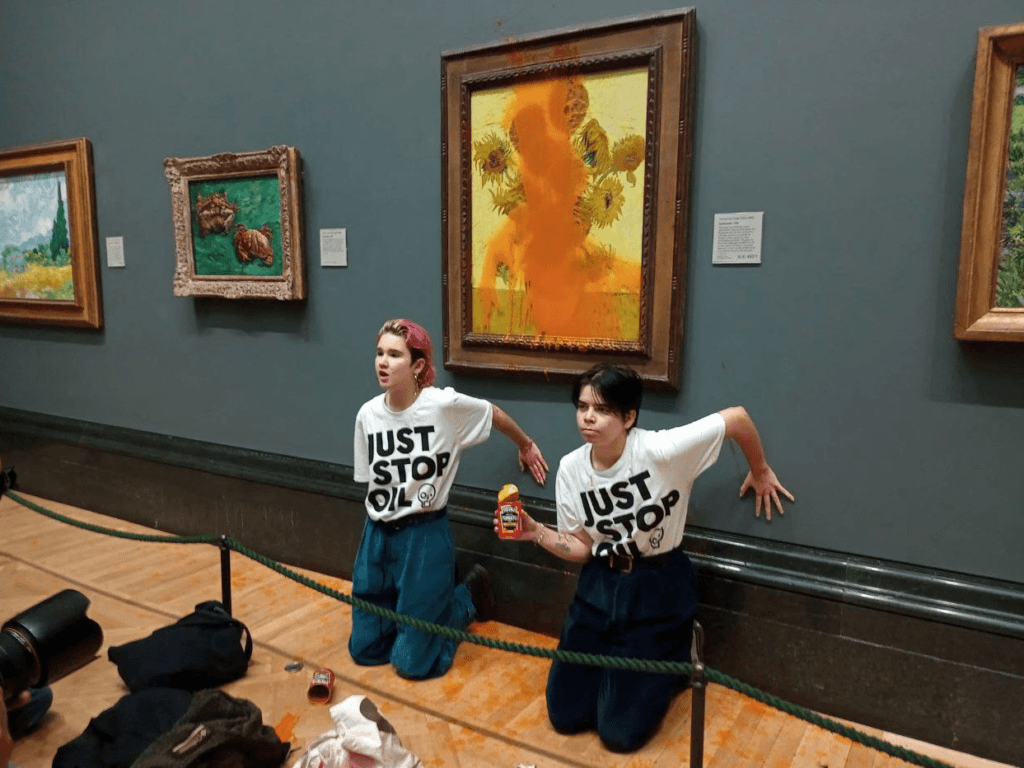Does climate action come at the cost of precious artwork?
Recently, famous paintings in museums have become the victim of civil disobedience to raise climate awareness. These include the Mona Lisa, “Sunflowers” by Van Gogh, and “Grainstacks” by Monet, among many others. In all of these cases, protestors threw food at the paintings, as well as glued their hands to the frames. One protester even tried to glue his head to “Girl With a Pearl Earring” by Vermeer. Most people involved claim that they ensure each painting has a glass cover before committing these acts, however, there have been minor damages to coatings and frames which have all been fixed.
When I first heard about these artwork protests, like many, I was shocked and confused. How does raising climate awareness relate to famous paintings? The answer is civil disobedience. Many, but not all, of these protestors are affiliated with Just Stop Oil, a UK based coalition with a goal to stop the UK government from granting licenses and consents for the exploration, development and production of fossil fuels. They do this through nonviolent, civil disobedience. This is the same tactic used by famous leaders like Gandhi, Mandela, and MLK jr. Civil disobedience, per its definition, is “the refusal to comply with certain laws or to pay taxes and fines, as a peaceful form of political protest.” In addition to this, civil resistance really strives to bring attention and viewership to different issues. Like bees to honey, people are attracted to juicy news about people taking drastic, unexpected measures that are often against the law or breaking society’s code of conduct. So, as the views on articles, videos and social media posts skyrocket, people begin discussing not only what happened, but why the people did what they did. In this way, people begin to learn more about the actual issue at hand. Their curiosity is sparked, and they are more likely to look into whatever the protestors were protesting about.
Just Stop Oil is doing exactly the same thing. Eyebrows are raised when people throw soup and mashed potatoes, and glue their hands, onto paintings. So, we begin to wonder why the protestors took these rather mind-blowing measures. We realize it’s for climate action and already our minds are more aware of this pressing issue. Nevertheless, Just Stop Oil did not begin with such tactics. They have done many strikes in front of government buildings, nuclear plants, and fossil fuel refineries. All of these are, naturally, much more directly related to the climate crisis. The move to art protests was due to a lack of impact and media attention the coalition was getting from their more expected forms of civil disobedience. It has clearly worked. Their international road-blocking protests were not nearly as omnipresent in the media as their tomato-soup hurling.
Further, these art protests do touch on many important issues. Mainly, it revealed that people are more outraged when objects are threatened to be ruined, compared to the real earth. Threatening to hurt an image, albeit an important one, raised more of collective shock than certain unprecedented natural disasters which have affected hundreds. These protests are also directed at more specific issues, rather than just general climate awareness. For example, according to their website, Just Stop Oil in the US is aiming to make President Biden declare a National Climate Emergency. Norwegian protestors are trying to end all oil exploration off the coast of Norway, a major oil supplier, while presenting feasible solutions for the future employment of oil workers. These resistance acts do have the potential to lead to changes in law and government.
On the other hand, harming artworks can be seen as an unprofessional attempt at media attention. While there are myriad other peaceful ways to raise climate awareness, it does instigate groups of people. Not only that, art protests throw around blame and negativity within a group of people who may have previously been unified in their attempt at climate justice. This can even demotivate others from joining the movement.
Should climate action come at the cost of precious artwork? If protestors commit to their promise of not harming the artwork, these acts of resistance effectively attract attention to important issues and symbolically reveal to the world our affinity to value goods rather than people, animals, and nature. However, art protests could spread to groups that do not share the same commitments of non-violence and no-harm. In order to ensure that we can make the greatest impact for the betterment of our climate on lawmakers, we must stay as unified and collaborative as possible. Therefore, it is best to engage in protests more directly related to climate justice and ending fossil fuels, rather than ones that, although successful in the moment, may have the potential to break up people working towards one goal by throwing around blame, and soup.

Sources:
Declare emergency. (n.d.). DECLARE EMERGENCY. Retrieved February 14, 2023, from https://www.declareemergency.org
Just stop oil – no new oil and gas. (n.d.). Retrieved February 14, 2023, from https://juststopoil.org/
Mattei, S. E.-D. (2022, July 5). Environmental activists have glued themselves to more paintings in U.K. —Frame damaged. ARTnews.Com. https://www.artnews.com/art-news/news/environmental-activists-have-glued-themselves-to-more-paintings-in-u-k-frame-damaged-1234633260/
Stopp Oljeletinga. (n.d.). STOPP OLJELETINGA. Retrieved February 14, 2023, from https://www.stoppoljeletinga.no
World’s museums urge climate activists targeting ‘irreplaceable’ art to stop. (n.d.). Washington Post. Retrieved February 14, 2023, from https://www.washingtonpost.com/lifestyle/2022/11/11/climate-change-protesters-art-museums/

